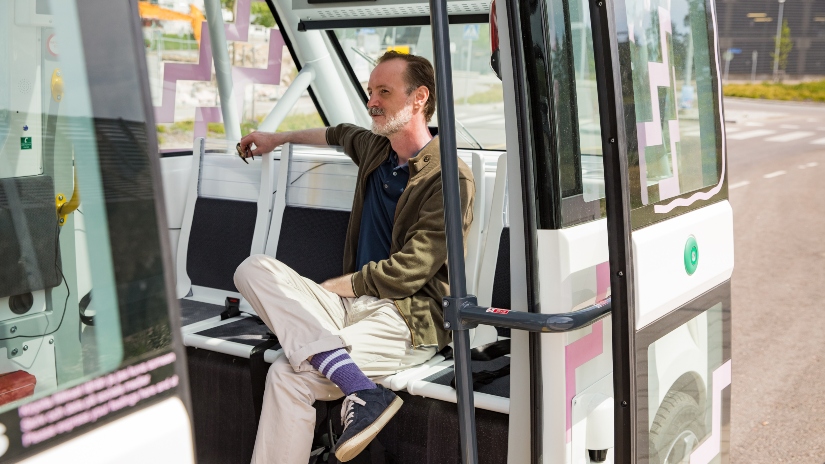By Harsha Badarinarayan Ph.D., Vice President, Hitachi America, Ltd.
To embody true equity, transportation must reflect and respond to the needs of the entire population, without favor or bias. Capturing that full spectrum of need is a gargantuan task in itself — one that can be realized successfully only through the collection and analysis of comprehensive data.
Public-private partnerships (PPPs) are ideally structured to facilitate the creation of this data-driven knowledge base and so are fundamental to the evolution of transportation equity. The combined resources of public and private entities produce a force for change that is greater than the sums of its parts. Equipped with cutting-edge technology and the capacity to finance large-scale capital projects, PPPs enable accelerated development and optimized operating efficiencies.
Those qualities, in turn, enhance efforts to launch pilots of transportation technology innovations such as driverless shuttles, mobility on demand, and e-bus or e-scooter services. Similarly, they contribute to the success and accuracy of initiatives that leverage advanced analytics, from using cameras to automate crowd estimation at transit points to accurately estimating transportation demand based on local events or other criteria.

In pursuing transportation equity, policymakers and private sector stakeholders must recognize and address the gulf that separates urban versus rural transportation options. While 31% of urban dwellers use public transit, The Rural Transit Fact Book notes that just 4% of people in rural households use public transit.1 The gap is exacerbated by limitations in availability, cost, and accessibility of taxi services in rural communities. (For example, many taxis are not compliant with the Americans with Disabilities Act [ADA].) The result: People in rural areas — and, disproportionately, seniors, low-income residents and people with disabilities in those communities — often lack access to food, medical care and other essentials. PPPs thus can achieve profound societal improvements in environmental impact, accessibility, affordability, and efficiency by focusing their efforts on transportation equity initiatives. The capacity of PPPs as engines for greater good extends to social equity and protection of the welfare of all people, regardless of their geographic location or economic status. Private-sector stakeholders can contribute their facility with advanced data analytics and artificial intelligence (AI) to accelerate PPPs’ progress toward the elimination of transportation-related disparities in society. For one thing, these capabilities enable digitization of transportation assets that are no longer served optimally by manual input or management, such as bookkeeping. But they can do so much more. For instance, digitization and the use of historical and real-time data can elevate planning and scheduling to enhance operations, maintenance and repair. Advanced modeling and forecasting capabilities can provide such accurate and actionable data that there is no need to redesign the entire service to realize significant improvements. In short, with PPPs as the catalyst, transit authorities can better manage, deploy and coordinate existing services and create a transit ecosystem that provides more personalized service to individuals within the community. Finally, transportation equity initiatives address the fallout from greenhouse gas emissions (one-third of which are generated by transportation) and their disproportionate impact on communities of color. While zoning provides one tool for addressing this issue, equity initiatives, by their nature, create platforms for structuring and sustaining solutions that can eliminate socioeconomic disparities in environment as well as transportation.

The collection of high-quality of data is critical for the achievement of transportation equity. Disparities in the quality of data encourage — and even require — more direct engagement between residents and policymakers. Transportation providers must assure access not only for people of color or people in low income brackets, but also for people who do not own vehicles, people with disabilities, and households in which English is not the primary language. For example, a good strategy for achieving outreach to members of marginalized groups is engagement with community-based organizers who already have strong connections to local residents and can help agencies better prioritize needs. Local data (from the census or locally collected sources) further strengthens this knowledge base and enables PPPs to develop a laser focus on the needs of the population. Essentials — schools, hospitals, child and elder care facilities, and so on — vary from community to community. Therefore, use of local data to customize the needs for that community is critical. This is particularly true in rural areas. Once there are established mechanisms for engaging all members of the community, policymakers gain greater access to hearing and understanding constituents’ opinions and concerns. This gives them the information they need to narrow the equity divide. Hitachi, through its Social Innovation Business, is accelerating innovation with partners all over the world to create social, economic and environmental value. We strive to co-create an efficient and sustainable future by reimagining the way society and various industries interact. Although federal initiatives are very helpful, large companies can create additional value by pursuing opportunities for partnerships that implement change at the state or community level. Key stakeholders within those partner ventures can include providers in such sectors as infrastructure (including local transit), communication (cellular companies), and data collection and storage (cloud providers). Hitachi collaborates successfully with each of those sectors as it provides value in the form of advanced transportation technology (both rail and automobile), advanced analytics and cybersecurity. Together, PPPs are in a unique position to realize transportation equity and bring value to people across every community. We’ll know we are there when we can measure significant improvements in wages, standards of living, caliber of schools and quality of health.

Vice President, Hitachi America, Ltd.
Harsha Badarinarayan is the Vice President of Research and Development at Hitachi America, Ltd. He has been with Hitachi for over 18 years. In his current role, Harsha is involved in Technology Strategy & Planning for automotive business expansion in the U.S., specifically related to the Autonomous Vehicles & Connected Mobility. His work focuses on developing automated driving technology and identifying potential go-to-market (GTM) opportunities for automotive-related use cases. Harsha holds 15 U.S. patents and has authored or co-authored over 30 technical publications.